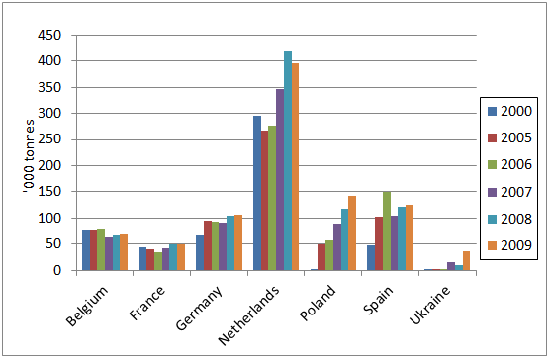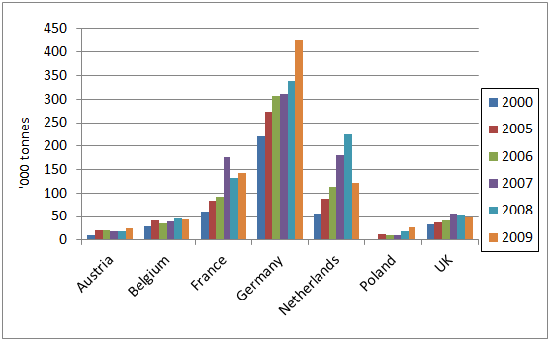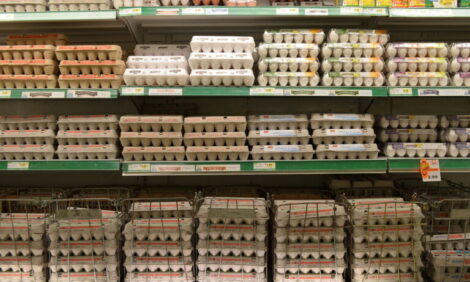



GLOBAL POULTRY TRENDS 2011 - Problems with European Egg Trade
Trade in egg and egg products is big business in the European Union, according to Terry Evans in his analysis of the egg industry in Europe. The region accounts for more than 60 per cent of global egg trade.While is difficult to determine what is currently happening in the production sector of the egg business because of the disruptions caused by the hen welfare legislation, it is equally so, if not impossible, to assess likely changes in trade. What is clear is that the regulations will have a dramatic impact on the volumes of shell eggs and products traded between EU member countries. Additionally, producers are concerned about the impact on their markets of imports of shell eggs and/or products produced from hens housed in traditional cages from third countries.
The monitoring of shell eggs can be done by ultraviolet light analysis, which can reveal markings on the eggshells of cage eggs. The source of these eggs can then be traced through contact with the competent authority in the member state of origin. In contrast, the source of imports of processed egg, principally in liquid or powdered forms, is more difficult to trace as the supply chain is less transparent and more challenging to audit.
Shell Egg Exports
Europe, or more specifically, the European Union, is the key player in the global shell egg trade. Hen egg exports in shell from the region at more than one million tonnes in 2009 (Table 1 and Figure 1) represented 62 per cent of the world total of 1.64 million tonnes. However, of the 1.1 million exported, 92 per cent were from EU countries.
Within the Community, the Netherlands is easily the leader in this field with shipments of around 400,000 tonnes. This total breaks down to reveal that 285,000 tonnes (72 per cent) went to Germany, 22,700 tonnes (six per cent) to Belgium, 14,000 tonnes (four per cent) to France and 13,600 tonnes (three per cent) to Switzerland.
Poland has become the next most important exporter in the EU, sales having escalated rapidly since joining the EU in 2004 to exceed 142,000 tonnes in 2009. Again, the main recipient was Germany, which accounted for almost 57,500 tonnes (41 per cent) followed by the Netherlands with 19,200 tonnes (14 per cent) and the Czech Republic with 13,700 tonnes (10 per cent). However, earlier this year, the Czech Republic, having announced that its country's egg industry had fulfilled the hen welfare requirements, imposed a ban on imports from Poland, claiming that the eggs were from birds kept in conventional cages. This will be a major problem for Poland since, because of difficulties in raising the necessary finance, a significant proportion of its flock is still considered to be kept in conventional battery cages.
Another country with similar problems to Poland is Spain. Exports in 2009 reached a peak of almost 125,000 tonnes. In this instance, the bulk of sales, amounting to almost 46,000 tonnes (37 per cent) were to neighbouring France, while Germany was the second most important customer with 20,000 tonnes (16 per cent).
Although exports from the Ukraine rose sharply during the review period, of the near 36,000 tonnes sold in 2009, some 19,000 tonnes were purchased by Iraq, with Syria and Kazakhstan the next significant buyers.

Shell Egg Imports
Regarding shell egg imports, Europe is responsible for around two–thirds of the global total. But, again the EU dominates accounting for 95 per cent of this total, with just three countries – Germany, France and the Netherlands combined purchasing 692,000 tonnes or 66 per cent of the European total (Table 2 and Figure 2).
More than three-quarters of purchases in Germany in 2009 were from the Netherlands, with Poland, Belgium and Spain being the other key suppliers, these four accounting for more than 91 per cent of the business.
Spain was the leading supplier to the French market sending 73,000 tonnes, followed by the Netherlands and Belgium with nearly 28,000 tonnes and 20,000 tonnes, respectively, these three being responsible for 85 per cent of France‘s shell egg imports.
Germany (42,000 tonnes) and Belgium (26,000 tonnes) were the main suppliers to the Dutch market though interestingly Poland sent nearly 17,000 tonnes and one cannot help wonder whether this market too will now close to Polish supplies.

Trade in Egg Products
Unfortunately, exports and imports of dried albumin are not included in FAO’s trade figures thus the picture revealed by tables 3 and 4 is incomplete. Nevertheless, based on the data available, Europe is clearly a significant player in both exports and imports of dried egg. On the export side, the Netherlands, France, Belgium and Italy feature strongly while, with regard to imports, Germany is the biggest market followed by Denmark and to a lesser extent, the Netherlands, France, Austria and surprisingly, Romania where the bulk of purchases came from Greece.
Europe dominates the trade in liquid egg accounting for 89 per cent of the global total of exports of 267,000 tonnes (table 5) and 83 per cent of imports using the export figure as the guide to the total that was imported rather than the import total shown in table 6. There are several problems with trade figures including the time lag between when exports are shipped and when they are received; that sometimes product is re-exported to another country and so the shipment is counted more than once; and lastly in some instances the quantities exported or impoprted may be recorded as part of another trade category.
Virtually all the trade in liquid egg in Europe is between EU member countries. The Netherlands heads the export league table followed by France, Spain, Germany, Poland and Belgium. The main buyer is, once again, Germany followed by France, Belgium, Denmark, Spain, the Czech Republic and the Netherlands.
April 2012














